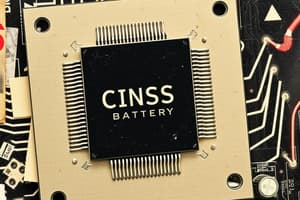Podcast
Questions and Answers
Which factor differentiates motherboards from one another?
Which factor differentiates motherboards from one another?
- Type and number of expansion slots (correct)
- Brand of the motherboard manufacturer
- Style of the logo printed on the motherboard
- Color of the motherboard
What is a common form factor for modern motherboards?
What is a common form factor for modern motherboards?
- Mini-PCI
- Pico-ITX
- XT
- E-ATX (correct)
Which component is typically assessed when comparing motherboards?
Which component is typically assessed when comparing motherboards?
- Chipset type and processor socket (correct)
- Number of USB cables included
- Motherboard color scheme
- Size of the packaging
What type of slots might you find on a motherboard designed for gaming?
What type of slots might you find on a motherboard designed for gaming?
In terms of memory support, which specification is important when selecting a motherboard?
In terms of memory support, which specification is important when selecting a motherboard?
Flashcards are hidden until you start studying
Study Notes
Motherboard Overview
- Essential component connecting all hardware in a computer system.
- Contains slots for processors, memory, and expansion cards.
Parts of the Motherboard
- Chipset: Determines compatibility with processors and peripherals.
- Processor Socket: Connects the CPU to the motherboard.
- Expansion Slots: Provide connectivity for graphics cards, sound cards, etc.
- Ports: Include USB, HDMI, and audio jacks for external devices.
Types of Motherboards
- ATX (Advanced Technology eXtended): Standard size for desktops.
- Micro-ATX: Compact version of ATX for smaller setups.
- Mini-ITX: Even smaller, used in compact systems.
- Pico-ITX: One of the smallest form factors, used in embedded systems.
Current Trends in Motherboards
- Gaming Motherboards: Enhanced performance and cooling systems; compatible with high-end GPUs.
- Internet of Things (IoT) Motherboards: Specific for connected devices; low power consumption, high efficiency.
Comparative Analysis Criteria
-
Chipset and Compatibility:
- Different chipsets support various features and processors.
- Important for determining overall system capability.
-
Expansion Slots and Connectivity:
- PCIe Slots: Used for adding graphics cards and other expansions.
- M.2 Slots: Faster storage options for SSDs; ideal for high-performance needs.
-
Memory Support:
- RAM Capacity and Speed: Affects overall system performance; important for gaming and professional applications.
- Memory Slots: Number of RAM slots determines upgrade potential.
Assessment Task
- Create a comparison matrix to analyze in detail based on chipset, expansion slots, connectivity, memory support, and I/O ports across various motherboards.
Studying That Suits You
Use AI to generate personalized quizzes and flashcards to suit your learning preferences.




